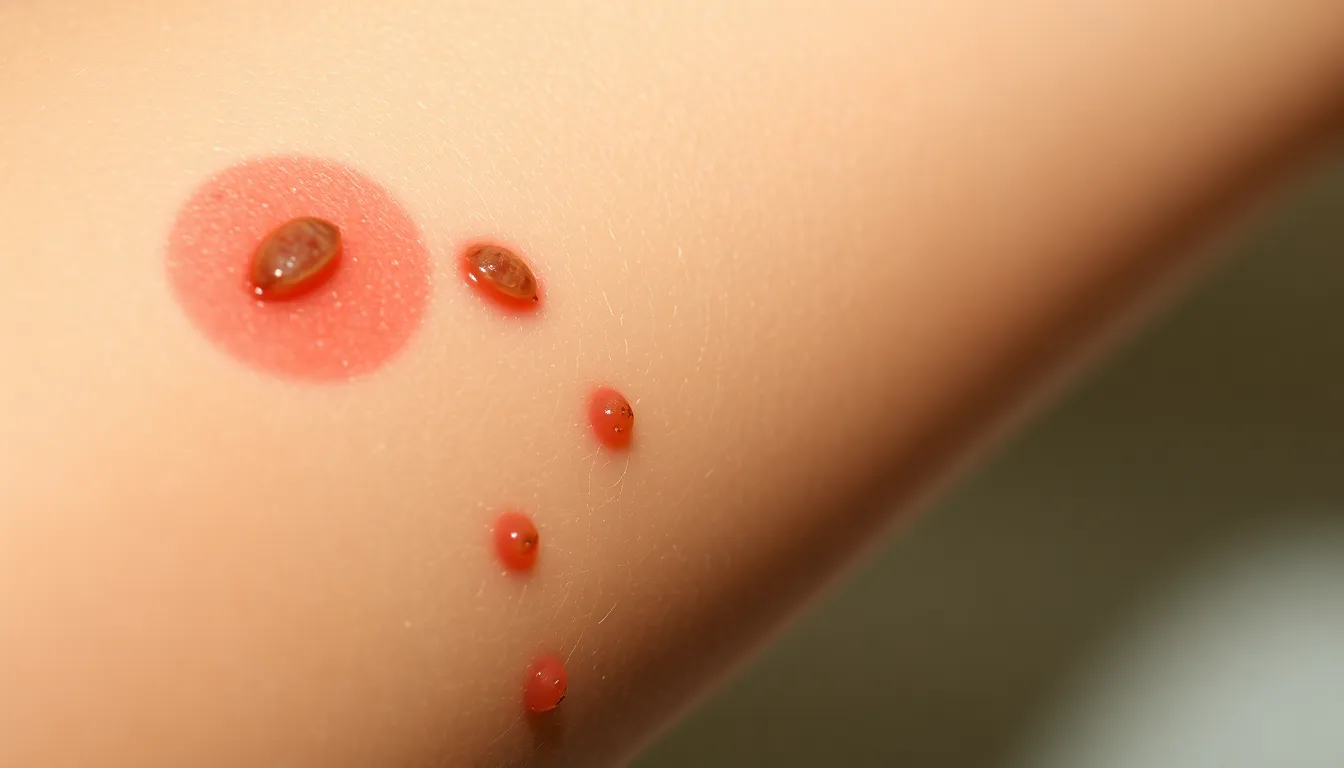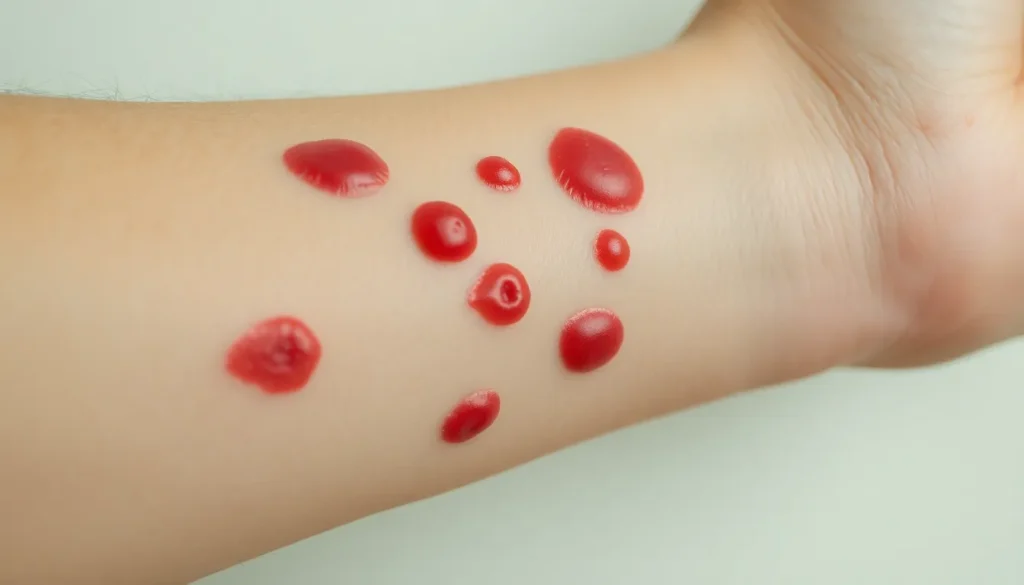Bed bug bites can leave many wondering about their appearance and how to identify them. Often mistaken for pimples, these bites can lead to confusion and concern. Understanding the differences between bed bug bites and common skin irritations is crucial for effective treatment and prevention.
These tiny, elusive pests can wreak havoc on a peaceful night’s sleep, and knowing how to spot their bites can help in early detection. Bed bug bites typically feature a distinct pattern and may appear red and swollen, similar to pimples. However, they often present with additional symptoms like itching and discomfort that set them apart. By recognizing these signs, individuals can take swift action to address an infestation and protect their homes.
Table of Contents
ToggleUnderstanding Bed Bug Bites
Bed bug bites manifest uniquely, often leading to confusion with other skin issues like pimples. Identifying bed bugs involves understanding their characteristics and feeding behavior.
What Are Bed Bugs?
Bed bugs are small, wingless insects belonging to the Cimex lectularius species. They typically measure between 4-5 mm in length and feature a reddish-brown coloration. These parasites primarily inhabit areas close to human sleeping environments, such as mattresses, bed frames, and furniture. Bed bugs lay up to five eggs per day, with rapid population growth possible under suitable conditions.
How Bed Bugs Feed
Bed bugs feed exclusively on blood, relying on human hosts for sustenance. During feeding, they use specialized mouthparts to pierce the skin and draw blood. Feeding usually occurs at night, allowing the insects to remain undetected. A single feeding session lasts around 5-10 minutes, leaving behind characteristic bite marks that may appear in clusters or a linear pattern. The bites can provoke allergic reactions, resulting in redness, swelling, and itching at the puncture site.
Characteristics of Bed Bug Bites

Bed bug bites display specific features that set them apart from other skin irritations, like pimples. Understanding the appearance and symptoms of these bites is vital for identifying infestations early.
Appearance of Bed Bug Bites
Bed bug bites typically appear as small, red welts that may resemble pimples. These welts are often surrounded by a reddened halo and are caused by the body’s allergic reaction to the salivary proteins introduced during feeding. Bites may cluster in groups of two to five or appear in a linear pattern, indicating the path of the bed bug as it feeds. Unlike many acne-related lesions, bed bug bites don’t develop a whitehead and may remain swollen for several days.
Symptoms of Bed Bug Bites
Symptoms of bed bug bites include intense itching, redness, and swelling at the bite site. Individuals may experience varying reactions depending on their sensitivity to bed bug saliva. Some may develop small blisters or hives. Scratching the affected areas can lead to secondary infections due to skin breaks. While these bites mainly occur at night, irritation can persist for days or even weeks, making timely identification essential for treatment and prevention.
Do Bed Bug Bites Look Like Pimples?
Bed bug bites can be mistaken for pimples due to their appearance. Both create raised lesions on the skin, making it essential to distinguish between the two for effective treatment.
Similarities Between Bed Bug Bites and Pimples
- Raised Appearance: Both bed bug bites and pimples appear as small raised bumps.
- Redness: Each type exhibits some level of redness surrounding the affected area.
- Itching and Discomfort: Both can cause discomfort, leading to scratching or irritation.
Differences Between Bed Bug Bites and Pimples
- Bite Pattern: Bed bug bites often cluster in groups of two to five or follow a linear pattern, while pimples can occur randomly across the skin.
- Associated Symptoms: Bed bug bites typically cause intense itching and may lead to hives or blisters, symptoms not usually present with pimples.
- Timing of Appearance: Bed bug bites occur mostly after feeding at night, whereas pimples may develop at any time due to various factors, including hormonal changes or clogged pores.
- Duration of Symptoms: Bed bug bites can remain itchy for days or weeks, while pimples generally resolve within a shorter period.
Treatment Options for Bed Bug Bites
Effective treatment for bed bug bites focuses on alleviating symptoms and preventing infection. This section outlines both home remedies and medical treatments available for managing the discomfort.
Home Remedies
- Cool Compress: Applying a cool compress to affected areas reduces swelling and soothes itching. Use a clean cloth soaked in cold water for relief.
- Aloe Vera: Using aloe vera gel provides anti-inflammatory properties that help calm irritated skin. Apply directly to bites for a soothing effect.
- Baking Soda Paste: Mixing baking soda with water to form a paste can alleviate itching and irritation. Apply it to the bites and rinse after 10 minutes.
- Oatmeal Baths: Adding colloidal oatmeal to a lukewarm bath can relieve itching and inflammation. Soak for at least 15 minutes for maximum benefit.
- Apple Cider Vinegar: Diluting apple cider vinegar with water can help disinfect the bite area. Apply it lightly with a cotton ball to minimize itching.
Medical Treatments
- Topical Corticosteroids: Using over-the-counter hydrocortisone cream can reduce inflammation and relieve itching. Apply as directed on the packaging.
- Antihistamines: Taking oral antihistamines, such as diphenhydramine, can help alleviate allergic reactions and minimize itching. Follow dosage instructions on the label.
- Prescription Creams: Consulting a healthcare provider may result in prescription topical treatments that provide stronger anti-inflammatory effects if symptoms persist.
- Antibiotics: In cases of secondary infections from scratching, healthcare professionals may prescribe oral antibiotics to treat bacterial infections.
- Professional Consultation: Seeking medical advice is crucial if symptoms worsen or do not improve after home remedies and over-the-counter treatments. A healthcare provider can recommend appropriate interventions.
Prevention Tips
Preventing bed bug bites involves proactive measures to reduce infestations and identify problems early. Following these guidelines can significantly minimize the risk of being bitten.
Reducing Bed Bug Infestations
- Seal Cracks and Crevices: Caulk gaps in walls, furniture, and baseboards to eliminate hiding spots for bed bugs.
- Use Mattress and Box Spring Encasements: Encase mattresses and box springs in protective covers specifically designed to keep bed bugs out.
- Regularly Wash Bedding: Wash bed linens, pillowcases, and pajamas in hot water weekly to kill any bed bugs or eggs.
- Declutter Living Spaces: Reduce clutter around sleeping areas, making it easier to spot and eliminate potential hiding spots.
- Inspect Used Furniture: Examine second-hand furniture for signs of bed bugs before bringing items into the home.
- Employ a Professional Pest Control Service: Hire a pest control expert to conduct routine inspections and treatments, ensuring infestations remain at bay.
Identifying Bed Bug Infestations Early
- Conduct Routine Inspections: Regularly check mattresses, box springs, and bed frames for live bugs or dark spot stains.
- Look for Shed Skins: Bed bugs shed exoskeletons as they grow. Finding these skins can indicate an existing infestation.
- Be Alert for Unusual Bites: Monitor for bite patterns on the skin, especially after waking, signaling bed bug activity.
- Use Bed Bug Monitors: Place monitors under furniture and beds to detect bed bug activity early.
- Educate Household Members: Inform everyone in the home about how to recognize bed bugs and their bites, promoting vigilance in spotting issues.
Conclusion
Identifying bed bug bites is essential for effective treatment and prevention. While they may resemble pimples in appearance, the distinct patterns and accompanying symptoms set them apart. Recognizing these differences can lead to timely intervention and help prevent further infestations.
By understanding the characteristics of bed bug bites and implementing prevention strategies, individuals can protect their homes and reduce the risk of these pesky intruders. Staying vigilant and informed is key to maintaining a bed bug-free environment.





